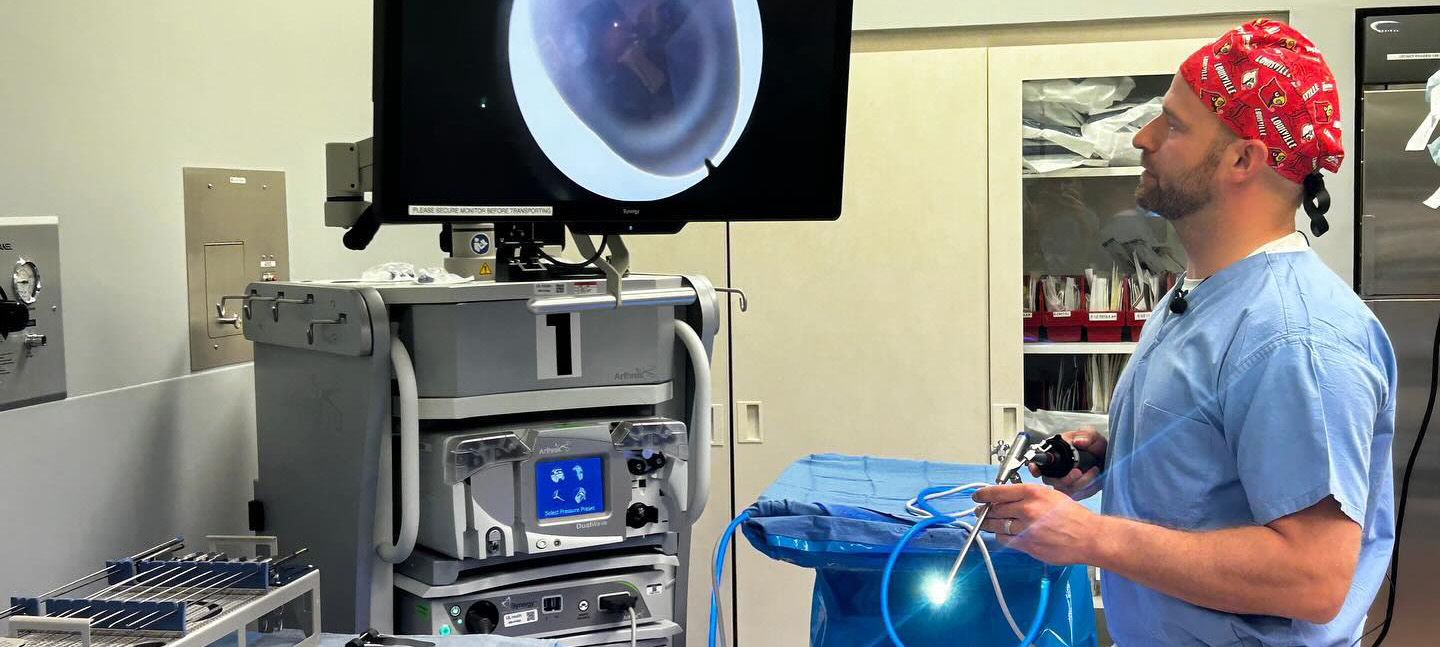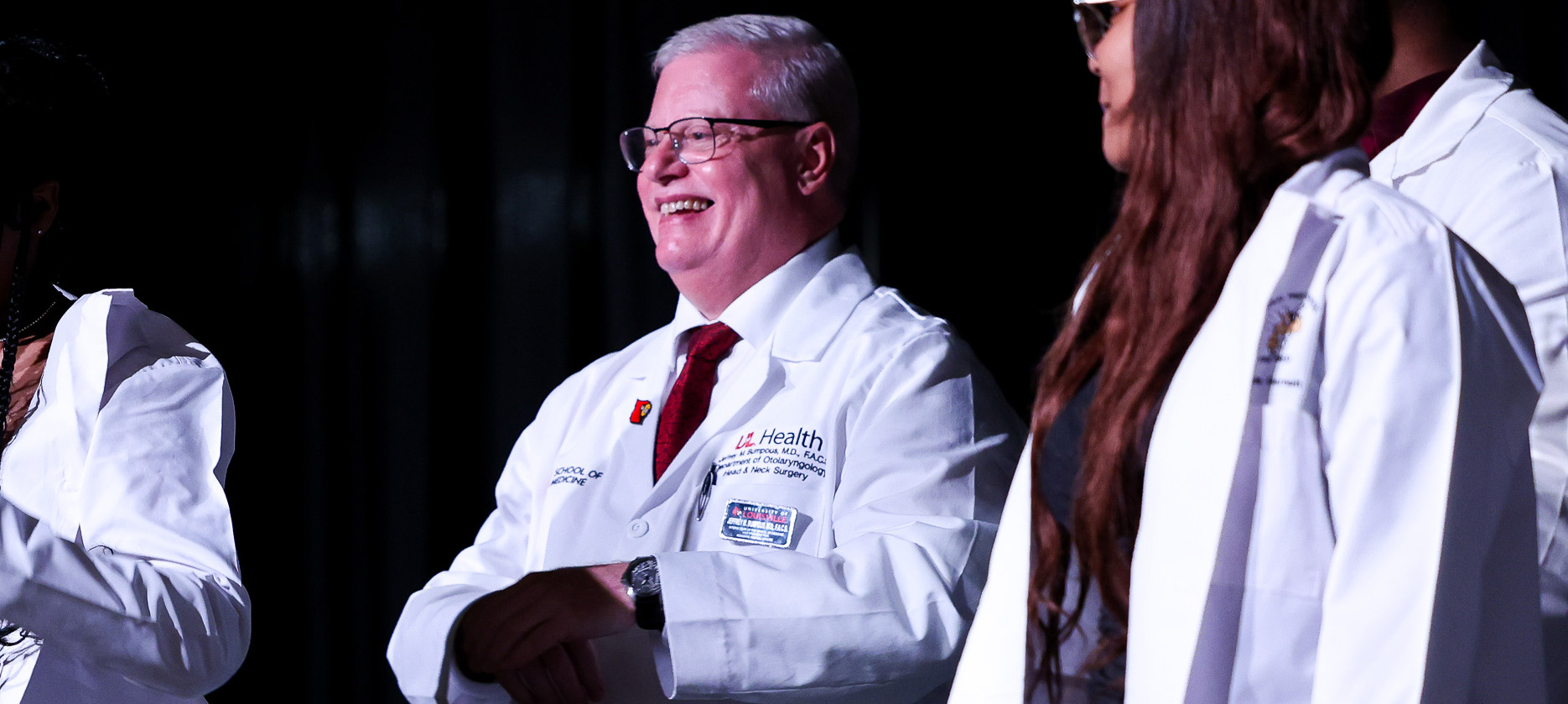
UofL Health – UofL Hospital has been transforming the health of the Louisville, KY community for 200 years.
1823

Photo provided by Kornhauser Health Sciences Library
The Falls of the Ohio led crews transporting goods to stop in the city of Louisville to maneuver the falls. During this stop, sick or injured crew members were forced off the boats and abandoned in Louisville with no home, no family and no options for health care. Thus, the Louisville Marine Hospital was created to care for these patients who needed a kind and caring place to receive their health care. These patients were often immigrants with a wide variety of backgrounds, ethnicities and countries of origin, and many barely spoke English.
The first hospital in Kentucky, Louisville Marine Hospital (which eventually became UofL Health – UofL Hospital), opened.

R. G. Potter Collection. [P_00571], Louisville, Kentucky; Archives & Special Collections, University of Louisville.
1836
Control of the Louisville Marine Hospital was given to the mayor and city council, meaning the hospital could be supported by city taxes. The hospital was renamed Louisville City Hospital. At this point, care was offered to those living in the city who could not afford health care. From the beginning, UofL Health has provided inclusive care to all people.
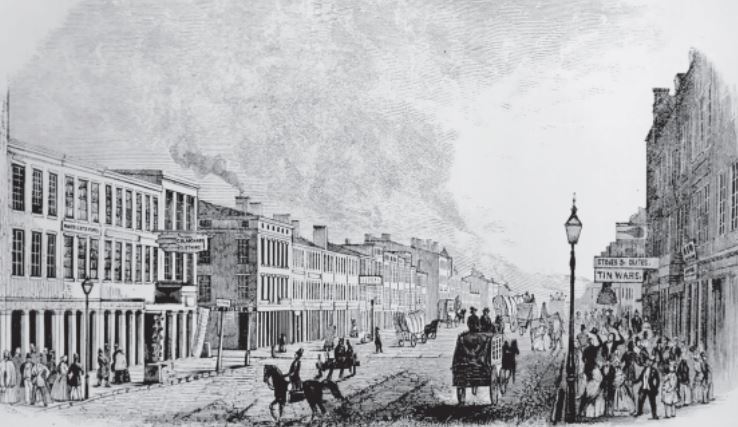
Creative Commons
1837
The Louisville Medical Institute (eventually the UofL School of Medicine) opened with resounding community support. The affiliation between the medical school and the hospital was mutually beneficial. The Louisville Medical Institute contributed the medical providers, while the Louisville City Hospital provided the patients and facility. The medical school is the ninth oldest in the United States, making it one of the oldest in North America.
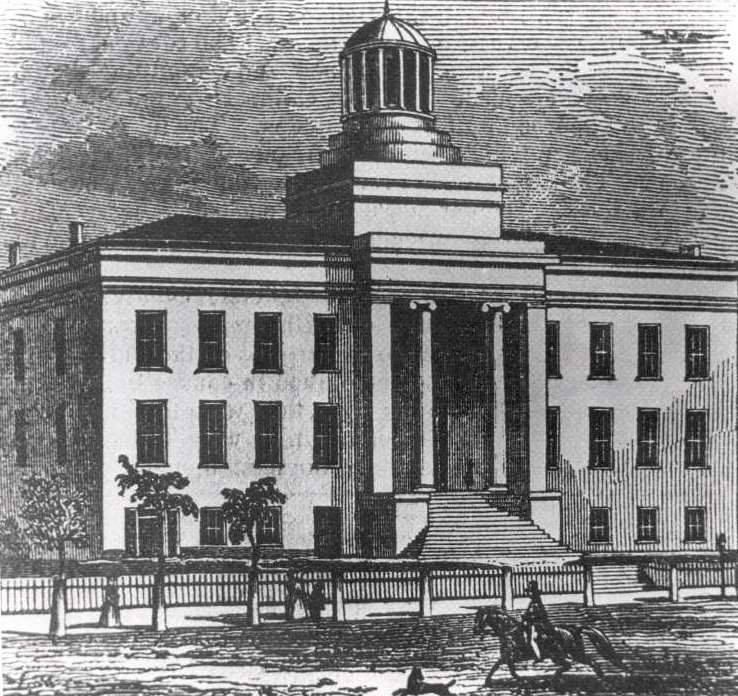
Kornhauser Health Sciences Library
1841
Dr. Samuel Gross, a physician at Louisville City Hospital, set up one of the first surgical laboratories in the country. He also performed the world’s first successful ligation of subclavian artery aneurysm. His work earned him great respect and he is considered among the most influential surgeons of the 19th century.

Kornhauser Health Sciences Library
1868
Following a foundation laid by the Freedmen’s Bureau, the hospital took on responsibility to care for freed slaves and began the development of several expansions to care for more patients.
1889
The School of Nursing of the Louisville City Hospital was established. The program took three years to complete and included working experience and courses in medicine, surgery, obstetrics, pediatrics, contagion, psychiatry, operation room techniques and dietetics. With time, this eventually became the UofL School of Nursing.

Kornhauser Health Sciences Library
1890s
Decades worth of research and medical advancements meant that surgery was becoming a specialized service with outlined processes and techniques. Operating rooms were added to Louisville City Hospital to give surgeons a space to perform these operations. Physicians and surgeons understood that to continue to improve treatment options for patients, their failures had to be studied just as much as their successes. The Louisville City Hospital installed autopsy rooms for such purposes.

Kornhauser Health Sciences Library
1911
The birth of trauma care in the United States came when Dr. R. Arnold Griswold and Louisville City Hospital started accident services. The primary mission of accident services was to care for patients with injuries and fractures. Later in the 1930s, Dr. R. Arnold Griswold worked with the Louisville Police Department to equip station wagons and firetrucks with medical supplies and train police on giving emergency care en route to the hospital, an early version of emergency medical services. Patients dealing with emergencies were brought to Louisville City Hospital specifically because they would be cared for regardless of their ability to pay. This service was the first of its kind and led to the hospital’s robust emergency department.
The announcement of the construction of a new, million-dollar hospital for Louisville City Hospital meant that it must move and operate in a temporary location. Louisville City Hospital’s tuberculosis patients were sent to Waverly Hills Sanatorium for treatment, marking an affiliation between the two hospitals. The rest of the patients were relocated to the hospital’s temporary quarters.
![1911 Waverly Hills: Joseph and Joseph Architects photograph collection. [1984_001_041], Waverly Hills, Kentucky; Archives & Special Collections, University of Louisville.](https://uoflhealth.org/wp-content/uploads/2023/11/1911_Waverly-Hills-1024x799.jpg)
Joseph and Joseph Architects photograph collection. [1984_001_041], Waverly Hills, Kentucky; Archives & Special Collections, University of Louisville.
1914
After three years in temporary quarters, the new state-of-the-art structure was dedicated. The new facility was a group of 11 buildings connected by one long corridor. The Louisville City Hospital was credited as one of the great municipal hospitals in America. Demand for care became so great that in March 1936, ground was broken for an addition to the hospital.

Kornhauser Health Sciences Library
1921
Dr. Alice Pickett became the first woman faculty member at the UofL School of Medicine, and chief of Obstetrics at Louisville City Hospital. As a leader in public health, Dr. Pickett established local and statewide clinics for prenatal care and birth control.

Kornhauser Health Sciences Library
1937
As part of the Ohio River flood of 1937, nearly 70% of Louisville was flooded and approximately 200,000 people were forced to evacuate their homes. Louisville City Hospital was the only hospital that remained open during the devastation and added a special “hospital boat landing.” Patients were brought to the front doors by boat.

Kornhauser Health Sciences Library
1938
Dr. R. Arnold Griswold was named chair of the Department of Surgery at the University of Louisville. Dr. Griswold invented an innovative device for fracture reduction known as the “Griswold Machine.” Dr. Griswold developed Louisville’s first blood bank as well as autotransfusion, the process of receiving your own blood as transfusion as opposed to a donor’s. Dr. Griswold was also among the early proponents of the utilization of seatbelts, testifying in Congress on the potential of lives saved.

Kornhauser Health Sciences Library
1941
World War II brought a new atmosphere to Louisville City Hospital. In order to treat wounded soldiers, the United States government added a wing to the hospital, which was later purchased by Louisville City Hospital. Throughout the war, medical students were put on an accelerated track and completed their residencies with the military. The military thought very highly of doctors who trained at the UofL School of Medicine due to the experience in trauma care they gained while working at the Louisville City Hospital.

Kornhauser Health Sciences Library
1942

Kornhauser Health Sciences Library
Before this point, only those in the city of Louisville were able to receive care at the Louisville City Hospital. With the merger of the city and county boards of health came great change for the hospital. The hospital changed its name to Louisville General Hospital and began to provide care for those in the city of Louisville and rural Jefferson County. Cassius Marcellus Clay Jr. (aka Muhammad Ali) was born at Louisville General Hospital.


Photos provided by Muhammad Ali Center
1948
Louisville General Hospital was the first public hospital in Kentucky to train a Black physician. Dr. Maurice F. Rabb was added to the hospital staff in 1948 as a part-time resident for advanced work in anesthesiology. Throughout his training, Dr. Rabb maintained his private practice.
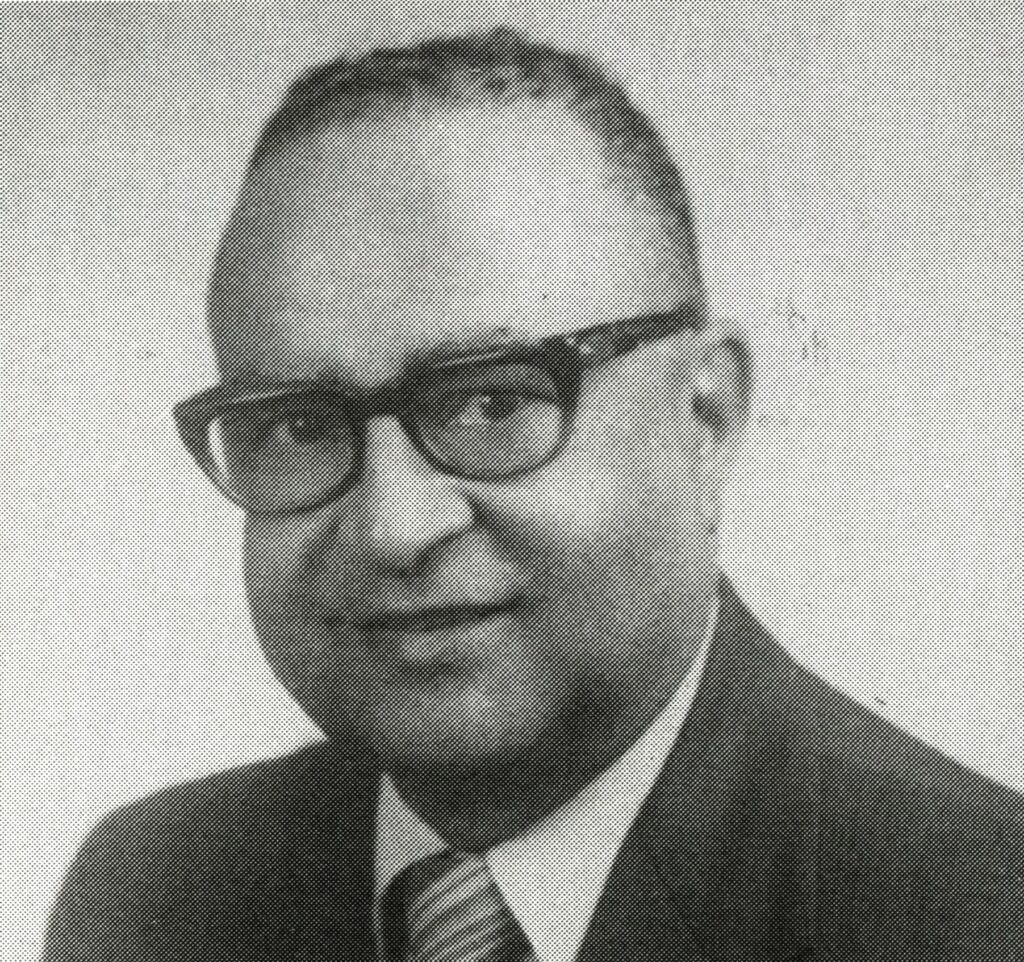
Kornhauser Health Sciences Library
1953
The University of Louisville Medical School and the Louisville General Hospital welcomed its first two Black faculty and physicians, Drs. Orville Ballard and Grace M. James. Dr. Ballard practiced medicine and Dr. James practiced pediatrics. Louisville General Hospital was one of the first hospitals in Louisville to welcome Black physicians.

Photos provided by Kornhauser Health Sciences Library and The Courier-Journal
1954
Flora Ponder, RN, became one of the first two Black nursing students at General Hospital. She later served as head nurse of Recovery and the ICU.

Photo provided by the University of Louisville
1971
Dr. Hiram C. Polk, Jr. joined the University of Louisville School of Medicine as the chair of the Department of Surgery and the chief of Surgery for Louisville General Hospital. Dr. Polk is known for his pioneering research on proper surgical antibiotic use to reduce surgical site infections, burn care, concepts in treatment of malignant melanoma, surgical oncology, hiatal hernia treatment, trauma surgery and systems development and many contributions in the development of contemporary surgical training methods and models.

Kornhauser Health Sciences Library
1977
Dr. Gordon Tobin introduced and performed the first tangential excision and early skin grafting of thermal burns in Kentucky. The technique greatly reduced burn mortality and morbidity, and it has become widely adopted. It also became a key component in the care of the 1988 Carrollton bus crash victims.

UofL Health Photo Library
1979
The University of Louisville secured ownership of Louisville General Hospital, which led to another name change for the hospital: University Hospital.
Now under the leadership of UofL, plans were established to begin a $52 million building project that would include a teaching hospital, ambulatory care building, and a parking garage. A $12 million cancer center was added to medical campus in collaboration with the Regional Cancer Center Corporation (RCCC).

Kornhauser Health Sciences Library
1981
Opening of the James Graham Brown Cancer Center was monumental for the region as it meant that cancer patients would no longer have to travel for treatment and care. RCCC raised the funds to construct the center and later donated it to the university in 1987.

UofL Health Photo Library
1983

UofL Health Photo Library
University Hospital opens with more than 400 beds, along with a state-of-the-art NICU, burn center, operating rooms and emergency services.

When the hospital opened it also brought the official designation as the only Level I Trauma Center, for adults, in the region and one of only two in Kentucky. Being recognized by the American College of Surgeons as ACS-Verified for Level I Trauma indicates that the hospital is able to provide care to the most severely injured patients. The fully Equipped Trauma Center makes the proper treatment of all significant injuries possible.

Kornhauser Health Sciences Library
The new University Hospital also expanded the reach of care with the hospital’s first helicopter services. STAT Flight. The perfect addition to University Hospital’s emergency department and Level I Trauma Center, the helicopter was started by a doctor who could start treatment before the flight arrived back in Louisville. The helicopter could travel about 130 miles, which reduced deaths in rural Kentucky and Southern Indiana by 10-20%.

Kornhauser Health Sciences Library
1988
The Carrollton bus crash of 1988 is known as the worst drunk driving-related crash in United States history. With 27 bus occupants fatally injured and 34 more facing minor to critical injuries, University Hospital was crucial in treating the injured. University Hospital was also critical in the fight for new bus safety laws and the addition of emergency exits through a side door, windows and roof.

Getty Images
1989
Victims of the shooting at Standard Gravure, the printing company that produced the Courier Journal newspaper, were rushed to University Hospital after the tragic incident and treated in the Level 1 Trauma Center. At the time, the shooting was the worst workplace shooting in United States history.
1997
The Sunbelt Melanoma Trial, conducted by University Hospital’s Brown Cancer Center, studied the long-term effects and efficacy of interferon, a treatment for melanoma patients on more than 3,600 participants. The results showed that thanks to current diagnostic techniques, most stage III melanoma patients do not benefit from treatment with interferon. This study by the Brown Cancer Center continues to save many patients from the unnecessary toxicity and adverse effects that come with the improper use of interferon therapy. Dr. Kelly McMasters was the principal investigator and initiated the trial that began in 1997 and the final results were published in 2016.

UofL Health Photo Library
2013
UofL Hospital became the first Joint Commission-certified Comprehensive Stroke Center in Kentucky, and only the 20th in the United States. This accreditation, led by Dr. Kerri Remmel, chair of the Department of Neurology, reflects UofL Hospital’s ability to treat patients with the most comprehensive stroke treatments that are available. Patients can expect the highest level of stroke care within minutes of arriving.

UofL Health Photo Library
2016
The first metastatic melanoma patient underwent the tumor-infiltrating lymphocytes (TILs) procedure at UofL Hospital, led by Dr. Jason Chesney, who was named director of Brown Cancer Center in 2017. TILs is the process of removing white blood cells from a patient, growing more of these cells in a lab, then reintroducing them to the patient’s body. The clinical care and research of UofL Hospital’s Brown Cancer Center made this procedure possible. The TILs procedure continues to save lives.

2020

UofL Health Photo Library
While the COVID-19 pandemic brought considerable uncertainty, UofL Health – UofL Hospital was at the forefront of care. The hospital developed the first drive-thru COVID testing site in Kentucky. When UofL Hospital became one of the first in the U.S. to receive the COVID vaccine, the testing site began to administer vaccinations. Dr. Jason Smith, chief medical officer, was the first in Kentucky to receive the vaccine. Endless thanks go out to the staff who were put on the frontlines throughout the pandemic.

UofL Health Photo Library
2022
UofL Health – UofL Hospital achieved the highest national recognition awarded to a hospital for excellence in nursing. The Magnet® designation reflects nursing professionalism, teamwork and superiority in patient care. Only select health care systems that meet rigorous standards receive Magnet® designation.
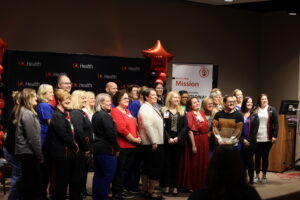
UofL Health Photo Library
2023
UofL Health – UofL Hospital – Burn Center became Kentucky’s first American Burn Association verified Burn Center. The high-quality patient care provided by the Burn Center at UofL Hospital helps patients from the time of injury through rehabilitation. The team includes nurses, physicians and rehabilitation specialists, all specially-trained to care for burn patients in the state-of-the-art burn unit.

UofL Health Photo Library
The Future...
Heading into our next century of service, UofL Hospital is once again evolving and investing to modernize patient care. The current facility is undergoing a $182.2 million expansion. When completed, the hospital will have all private rooms, 20 operating rooms, expanded emergency room capabilities and an additional 24-bed observation unit. The first phases of the project are expected to be completed in early 2025.

UofL Health Photo Library


